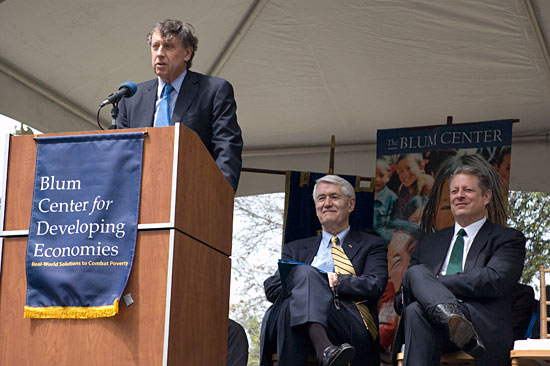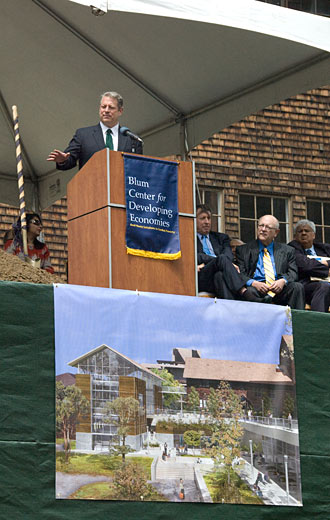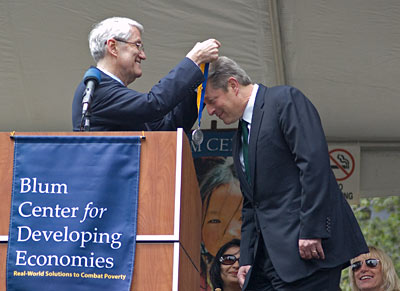| Richard Blum, whose gifts made the Blum Center for Developing Economies possible, speaks at Thursday's groundbreaking for the center's new building. Joining him on stage are Chancellor Birgeneau and former Vice President Al Gore. (Steve McConnell/ NewsCenter photos) |  |
An impatient man, a hopeful moment
At the groundbreaking for the Blum Center, Al Gore paid tribute to its founder and, especially, to the students whose engagement gives it such promise to aid the world's poor
| 24 April 2009
BERKELEY — The success of the three-year-old Richard C. Blum Center for Developing Economies and the explosion of student interest in addressing global poverty through its programs were points of pride for Vice President Al Gore, Blum, and others at Thursday's groundbreaking ceremony for the center's new campus home, with each speaker lauding student commitment as the key to alleviating poverty and, in turn, preserving the planet.
Gore called the groundbreaking "a happy and hopeful moment," adding that "what's made this so exciting is the demonstrated commitment of the student body here to the center's curriculum . . . how you have flocked to learn what is available to be learned in this center."
The ceremony took place at the soon-to-be construction site for a new building to house the Blum Center, adjacent to the Naval Architecture Building on the north side of campus. The interior of that historic building will be renovated as well, as an additional home for center activities and for the Department of Industrial Engineering and Operations Research. Construction is scheduled to begin at the end of this year and be completed in 16 months.
Gore, on campus to celebrate the new center as a longtime and close friend of Blum, spoke eloquently about its work and growing cadre of students, but also about the crucial connection between global poverty and the environmental issues he has championed.
 Al Gore speaks about the connection between global poverty and climate change. Hung below the podium is an artist's rendering of the Blum Center's new home.
Al Gore speaks about the connection between global poverty and climate change. Hung below the podium is an artist's rendering of the Blum Center's new home.A Nobel Peace Prize and Academy Award winner, the former vice president emphasized the challenges that lie ahead for those who undertake those commitments.
"One of the barriers to building a global agreement that will finally solve the climate crisis," he said, "is bridging the divide between the wealthy countries and the poor countries, between the developed countries and the developing countries." The Blum Center, he said, "will be one of the key places where that piece of the puzzle is solved, and where it is fitted in as the capstone of the arch."
Gore's remarks were greeted by a standing ovation, and Chancellor Robert Birgeneau honored him at their conclusion by presenting Gore with the Berkeley Medal, the campus's highest honor.
Richard Blum, a financier and philanthropist who is a Berkeley alumnus and chair of the UC Board of Regents, established the center with a $15 million gift in 2006. He was singled out for praise — by Gore, Birgeneau, UC President Mark Yudof, and Engineering Dean Shankar Sastry — almost as often as were the students who have spurred the center's dramatic growth.
Yudof testified to the can-do energy and focus that are hallmarks of Blum's approach to most things UC-related. He noted that Blum, with whom he works closely on a range of university matters, "isn't a very patient man. He doesn't have patience for complex administrative bureaucracies; he doesn't have patience for people who haven't done their homework; and he doesn't have patience for the condition of chronic poverty in which so many people around the world currently live."
Blum said his longstanding interest in global poverty was stimulated by his first visit, 40 years ago, to Nepal as a climber and trekker in the Himalayas. "I fell in love" with the people there, he recalled, in particular with Nepalis "who needed a little help" to deal with the region's chronic poverty, and the diseases and malnutrition that regularly accompany it in the developing world. His engagement led to creation of the American Himalayan Foundation (in association with such partners as the late Sir Edmund Hillary and the Dalai Lama), which now, Blum said, has some 175 projects active in the Himalayas.
 Following Al Gore's address, Chancellor Birgeneau presents the former vice president with the Berkeley Medal, the campus's highest honor.
Following Al Gore's address, Chancellor Birgeneau presents the former vice president with the Berkeley Medal, the campus's highest honor.Birgeneau also praised the faculty who, nearly overnight, he said, joined the work of the Blum Center and focused their energies on working with it to address global-poverty issues. He singled out Sastry and Ananya Roy, professor of city and regional planning and education director for the center, for their efforts.
Sastry, dean of the College of Engineering and faculty director of the Blum Center, noted the work already being done by its faculty/student teams — 250 students are currently working in 38 countries on projects involving 30 faculty members from a range of disciplines.
"Our faculty and students," Sastry said, "are delivering real-world solutions to improve the lot of the poor all across the world by combining the best new technologies, services, and business and financial models to provide scalable and sustainable solutions for one of society's most profound problems."
Work to date has included bringing safe water and sanitation to people in eight countries; deploying energy-efficient technologies across Africa and Asia, including the highly efficient "Darfur stove" that Lawrence Berkeley National Laboratory helped develop; and the development of wireless technologies to improve health care for the poor, such as the Cellscope, which allows transmission of blood-sample data from remote areas to health facilities in distant cities.
When the speeches concluded, all that remained undone was the actual breaking of ground. With six shovels and a mound of dirt at the ready, Birgeneau signaled the appropriate moment with a "count-up" — "One, two, three … Go Bears!" — and the lineup of dignitaries, faculty, and students donned Cal hardhats and dug in as one. With simultaneous flips of shovelfuls of soil, they launched a new phase for the Blum Center.

